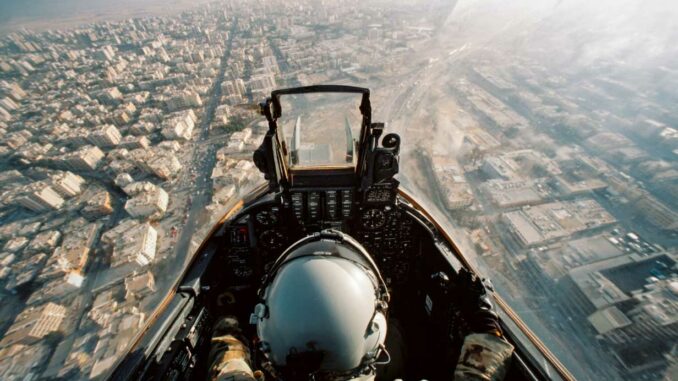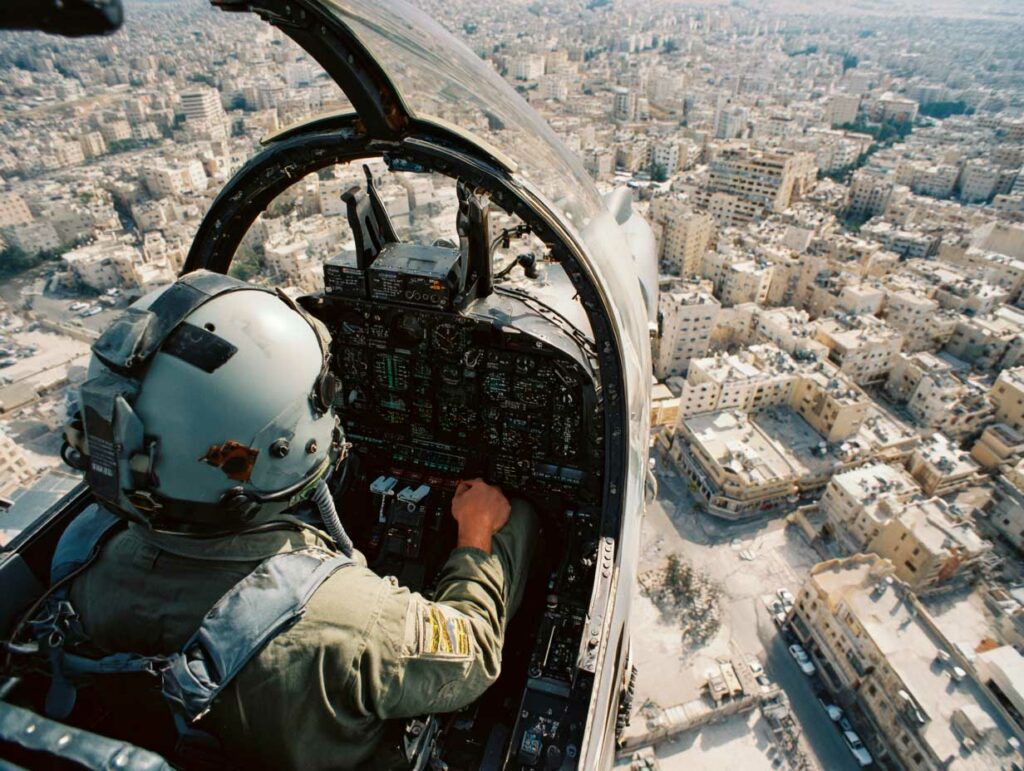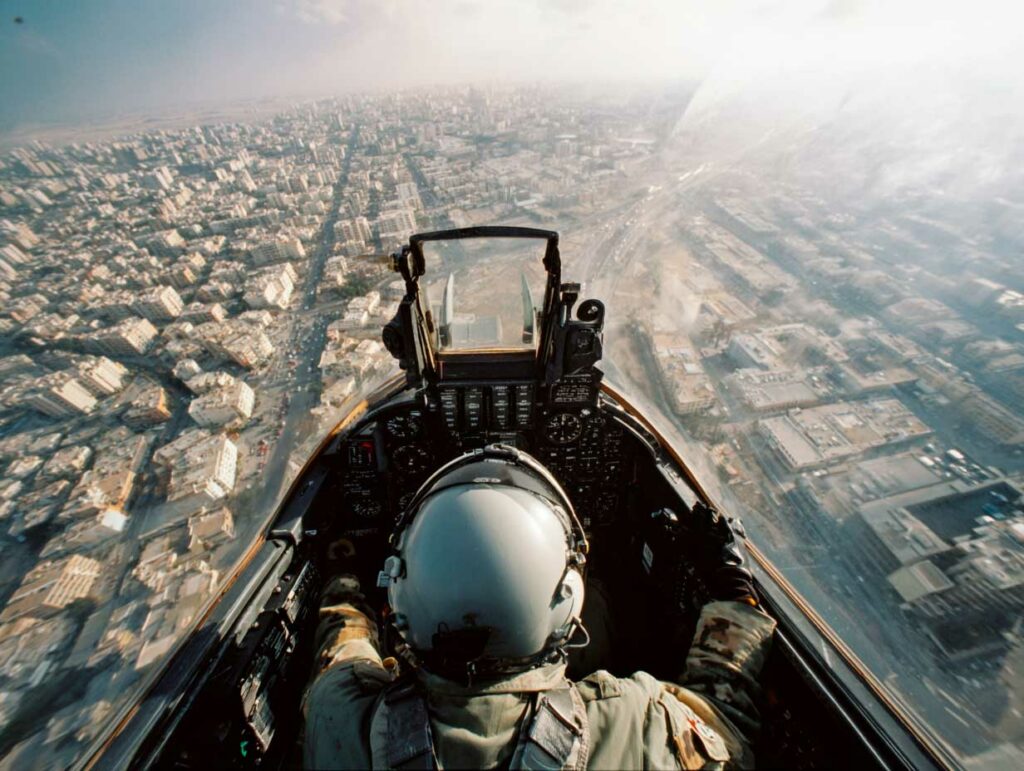
What processes lead to an air strike in an urban area? Technical analysis of the choices made by the forces involved in targeted ground attacks.
Engaging ground targets in urban areas using fighter jets or military drones is one of the most complex acts from a tactical, operational, and legal standpoint. These situations require a careful balance between military effectiveness and collateral civilian risks. The density of buildings, the presence of civilian populations, and the frequent use of civilian buildings by enemy combatants make the rules of engagement extremely strict.
Whether it is a planned strike or an opportunity for an attack in flight, air intervention in an urban area follows a structured decision-making process that takes into account legal factors (law of armed conflict), operational constraints (reduced time windows, formal identification), and technical data from ISR (Intelligence, Surveillance, Reconnaissance) intelligence.
Modern ground attack systems, piloted from a multi-role fighter aircraft or a MALE drone, allow for greater precision, but this does not eliminate the need for human validation before firing. Coordination between intelligence units, operational commanders, and weapons operators is a pillar of strike doctrine in populated areas.
This article examines the concrete decision-making processes implemented to conduct an urban ground attack, taking into account the current constraints of asymmetric warfare and technological developments in targeting and automation.

Legal validation prior to any ground attack
Before any strike by a fighter jet or armed drone in an urban area, there is an initial legal filter. The armed forces must demonstrate that the intended objective is a legitimate military target, in accordance with Article 52 of Additional Protocol I to the Geneva Conventions. This rule requires that the destruction or neutralization of the target must provide a concrete and direct military advantage.
In densely populated areas, the presence of civilians requires a collateral effects assessment (CEA). This procedure estimates the potential loss of non-combatant life, damage to civilian infrastructure, and the strategic impact of a poorly calibrated strike. According to NATO or Western military standards, a maximum threshold for civilian casualties is defined by the rules of engagement (ROE), often set at zero in highly sensitive environments.
The procedure involves validation by officers from the Joint Targeting Cell (JTC), often located outside the theater of operations. These analysts cross-reference ISR data (satellite imagery, electronic interception, human sources) to confirm that the identified target is indeed occupied by an enemy force. Misinterpretation or outdated data can result in the immediate cancellation of the strike.
This process can take between 15 minutes and several hours, depending on the responsiveness of the command systems. So-called “time-sensitive” targets sometimes benefit from exemptions, provided that the identification is visually confirmed by an active sensor (laser sensor, FLIR, etc.) and that an authorized commander gives his approval.
This legal filter aims to protect civilian populations, but also to prevent diplomatic damage that could result from a poorly executed strike. Errors affecting hospital or school areas in the past have led to strategic reviews and sanctions against the command chains involved.
A coordinated operational process between tactical levels
Once the target has been legally validated, the next step is the tactical decision-making process. Ground attacks in urban areas must be planned to minimize the margin of error while ensuring a clear military effect. To this end, a process known as the Dynamic Targeting Cycle is activated, mobilizing a hierarchical chain of responsibility.
The fighter jet or armed drone receives the target’s coordinates via a secure communications network. This network may include ground stations, relay aircraft such as the E-3 Sentry, or advanced command centers deployed nearby. The crew or operator also receives a mission profile: type of ammunition, firing trajectory, angle of impact, and precise time of engagement.
In the case of a shot fired from an F-16, Rafale, or a drone such as the MQ-9 Reaper, geolocation data is cross-referenced with real-time mapping provided by onboard sensors (SAR radar, Litening pod, infrared cameras). The ability to make a positive identification of the target (PID) is essential. In urban areas, a simple vehicle can be mistaken for an ambulance, a workshop, or a civilian building.
The trajectory of the missile or bomb is adjusted to avoid blast effects in residential areas. The munitions used are often low-yield laser- or GPS-guided bombs, such as the 113 kg GBU-39, capable of penetrating a floor without affecting adjacent structures. Some strikes also use shaped charge munitions, designed to limit the dispersion of fragments.
Finally, a restricted firing window is imposed: firing can only take place during a given period of time, when civilians have left the area or the tactical situation is stable. Any change on the front line triggers an immediate reassessment. Delays or hesitations are not due to technical errors, but to multiple validations, which are essential in this context.

The growing role of artificial intelligence and predictive analysis
Since 2022, armed forces incorporating artificial intelligence have significantly reduced the time between detection, validation, and firing. However, in urban areas, the use of AI in ground attacks remains strictly regulated. Algorithms are used for data sorting, modeling the effects of explosions, and behavioral analysis of targets.
For example, optical sensors on board a fighter jet are linked to AI capable of recognizing patterns of suspicious activity, such as groups of armed individuals, repetitive movements toward a strategic point, or prolonged parking near a known military depot. This data can generate an alert, but does not replace human decision-making.
Predictive analysis also applies to civilian evacuation routes. Systems such as Find-Fix-Finish are capable of cross-referencing visitor schedules, residents’ habits, and video feeds to determine when an area is least populated. This data is integrated into the fire algorithm, which informs the command center of the best time for engagement.
Simulation software such as FAST-CD (Fast Assessment Strike Tool – Collateral Damage) allows users to visualize the impact of a strike on a building in 3D. These tools, deployed within the Joint Air Operations Center, help to choose the least destructive vector possible.
Finally, lightweight drones are increasingly being used for precision missions in urban centers. The Switchblade 300, for example, weighs only 2.5 kg and carries a minimal payload. It can neutralize an armed individual or light artillery without affecting surrounding structures.
But these tools should not obscure one truth: the responsibility for engagement remains human. Artificial intelligence serves only to improve the quality of decisions. Failures in several recent conflicts (notably in Gaza and Syria) have highlighted that overreliance on automated data can lead to serious errors of judgment.
War Wings Daily is an independant magazine.